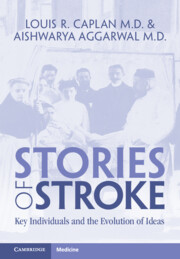Book contents
- Stories of Stroke
- Stories of Stroke
- Copyright page
- Contents
- Contributors
- Why This Book Needed to Be Written
- Preface
- Part I Early Recognition
- Part II Basic Knowledge, Sixteenth to Early Twentieth Centuries
- Part III Modern Era, Mid-Twentieth Century to the Present
- Types of Stroke
- Some Key Physicians
- Imaging
- Care
- Treatment
- Chapter Forty Three Clinical Stroke Trials
- Chapter Forty Four Heparin
- Chapter Forty Five Warfarin
- Chapter Forty Six Direct Oral Anticoagulants
- Chapter Forty Seven Aspirin
- Chapter Forty Eight Other Antiplatelets
- Chapter Forty Nine Other Medical Treatments
- Chapter Fifty Neuroprotection
- Chapter Fifty One Thrombolysis
- Chapter Fifty Two Treatment of Cerebral Venous Thrombosis
- Chapter Fifty three Recovery and Rehabilitation
- Chapter Fifty Four Carotid Artery Surgery
- Chapter Fifty Five Angioplasty and Stenting
- Chapter Fifty Six Endovascular Treatment of Acute Ischemic Stroke
- Chapter Fifty Seven Brain Aneurysm Treatment
- Chapter Fifty Eight Medical and Surgical Treatments of Intracerebral Hemorrhage
- Chapter Fifty Nine Treatment of Vascular Malformations
- Part IV Stroke Literature, Organizations, and Patients
- Index
- References
Chapter Fifty Nine - Treatment of Vascular Malformations
from Treatment
Published online by Cambridge University Press: 13 December 2022
- Stories of Stroke
- Stories of Stroke
- Copyright page
- Contents
- Contributors
- Why This Book Needed to Be Written
- Preface
- Part I Early Recognition
- Part II Basic Knowledge, Sixteenth to Early Twentieth Centuries
- Part III Modern Era, Mid-Twentieth Century to the Present
- Types of Stroke
- Some Key Physicians
- Imaging
- Care
- Treatment
- Chapter Forty Three Clinical Stroke Trials
- Chapter Forty Four Heparin
- Chapter Forty Five Warfarin
- Chapter Forty Six Direct Oral Anticoagulants
- Chapter Forty Seven Aspirin
- Chapter Forty Eight Other Antiplatelets
- Chapter Forty Nine Other Medical Treatments
- Chapter Fifty Neuroprotection
- Chapter Fifty One Thrombolysis
- Chapter Fifty Two Treatment of Cerebral Venous Thrombosis
- Chapter Fifty three Recovery and Rehabilitation
- Chapter Fifty Four Carotid Artery Surgery
- Chapter Fifty Five Angioplasty and Stenting
- Chapter Fifty Six Endovascular Treatment of Acute Ischemic Stroke
- Chapter Fifty Seven Brain Aneurysm Treatment
- Chapter Fifty Eight Medical and Surgical Treatments of Intracerebral Hemorrhage
- Chapter Fifty Nine Treatment of Vascular Malformations
- Part IV Stroke Literature, Organizations, and Patients
- Index
- References
Summary
Early descriptions of brain arteriovenous malformations (AVMs) were based on their appearance uncovered during surgical exploration. The first report of a spinal AVM was provided by Gaupp in 1888. He described the lesion as a “hemorrhoid of the pia mater” [1]. That same year D’Arcy described an arterial angioma of the angular gyrus at autopsy. The patient presented with right hemiplegia and later died of intracranial hemorrhage [2].
- Type
- Chapter
- Information
- Stories of StrokeKey Individuals and the Evolution of Ideas, pp. 590 - 604Publisher: Cambridge University PressPrint publication year: 2022

